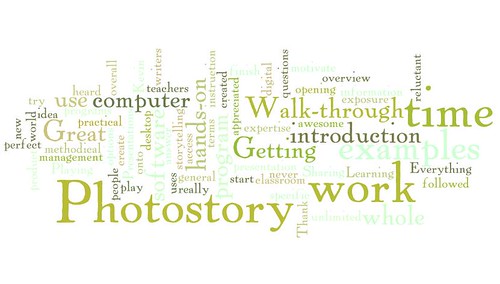
(Note: a wordle of comments from teachers on what they enjoyed from the workshop)
Saturday morning, in my school library, there were about 25 of us wrapping our minds around digital storytelling at an event called Digging into Digital Storytelling and we were doing it in a very concrete way: by playing with the technology and discussing the implications for the classroom. This is the second annual conference that our Western Massachusetts Writing Project Technology Team has hosted (last year, we presented a Technology Across the Curriculum event) and we kept true to our values in the National Writing Project:
- Teachers were teaching teachers
- Writing was the heart of what we were doing
- Sharing and reflection were built into the day
- Activities were designed for participation
The day began with an overview of digital storytelling, allowing us to conceptualize the role of student as composer of multimedia stories. This was an audience of folks completely new to the field but who were interested in learning more about how to engage their students with media production and digital stories. (One teacher admitted she had never even heard the term “digital storytelling” prior to the event).
I shared out information about the Collaborative ABC Movie Project from a few years back, shared some student movies from our Memory Object project, and then two of my technology team members — Mary and Tina — shared movies, too. Tina showed a wonderful story about a local place that holds a place in her heart and Mary showed a story in which her students talked about a water table experiment they had done.
Then, with a quick step-by-step tutorial of Photostory, they dug in.
I had asked them to consider bringing their own flash drives with images to tell their own story, and most did. Within minutes, they were composing. Some were stories of places; others were stories of people. One created a movie based on a poem of love that she had written for her partner and selected images. A few worked on ideas that their students might work on.
It was wonderful to watch and they were very engaged in what they were doing. Just like students, when you give them the time and scaffolding to succeed.
Our plan was to transition halfway through the day to explore Voicethread, but everyone was so immersed in Photostory that it didn’t seem like the right thing to do. So, we suggested that they keep working on Photostory and then, for the last 30 minutes, I would walk them through Voicethread. They all agreed, and appreciated the flexibility of the workshop to accommodate what they were doing. I can’t stand it when a workshop presenter has no clue what the audience is up to, so I try to stay tuned in with where people are and what they need to keep learning.
The final reflections — we called it a Ticket to Leave — were overwhelmingly positive, with folks noting that the time to play and explore was crucial for them as they think about how they can bring the concept back to the classroom.
Here are some of the ways they hope to move the concept into the classroom:
* Using Photostory for fluency project
*I see a lot of promise for September, especially with public speaking class
* I will use this in World Civilization and Integrated Vocational Skills classes
* You sparked collaboration with other teachers and learners — an idea I might develop through either blogs with students/or possibly voicethread
* Using this with my fourth graders who are trying to remember parts of essay writing
* Remediation project of an argumentative essay
* I hope to use digital storytelling for a long-term science experiment in mummification
* Introduce the idea to my juniors and seniors as a possible tool for use on their research presentations on topics ranging from Buddhism to Heien Japan to Medeival art in Europe
One thing I wish we had done with them: create a gallery walk of all of the movies they were working on so that participants could see what each had been doing during the time together. I realized later that they were most likely interested in each other’s work and we had not provided them an official glimpse into their efforts.
One more note: Almost everyone agreed that Photostory was easy to use and most admitted their struggle now was not with the technology but with their technology coordinators. Since Photostory is a downloaded program (free from Microsoft), they would have to go through hurdles to get it on desktops or into their system, and I could sense most would at least pursue the request but for how far? When we grapple with access to technology, it is often as much about the equipment as it is the help from the so-called experts who really see themselves as gatekeepers. If you are a technology coordinator, give the teachers the keys to the closet, please. Most don’t want to rock the boat and will give up on an idea if it means coming into conflict with the technology coordinator. That’s my opinion, anyway.
Peace (in reflection),
Kevin


